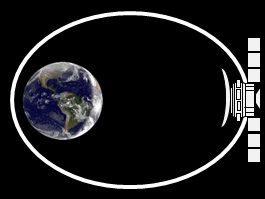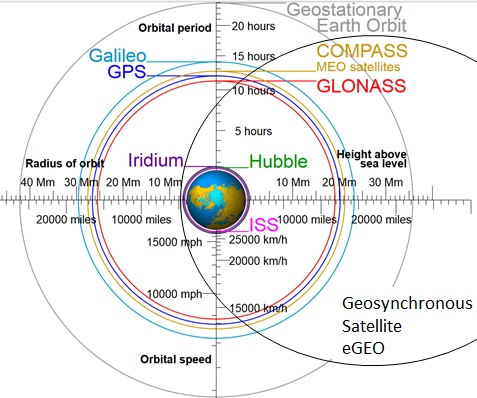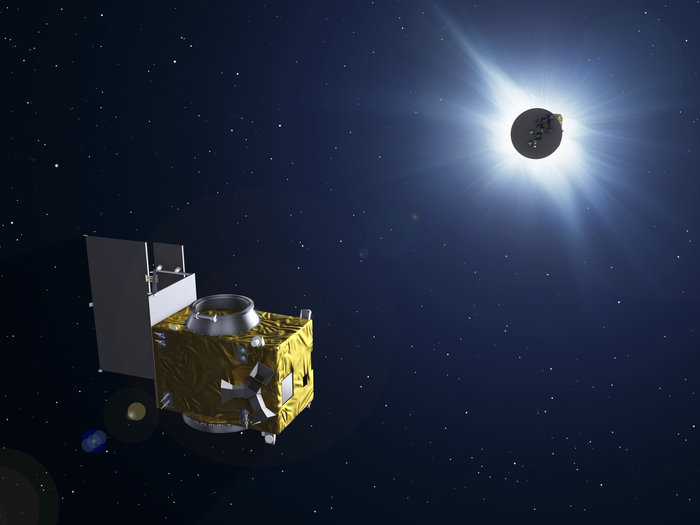|
Copyright ©2016 by Paul Niquette. All rights reserved. |
||||||
 Man-made
orbits are generally circular, best exemplified by
the equatorial geostationary
orbit (GEO), with its
hundreds of satellites, some with 'transponders'
delivering, say, television broadcasts to rooftop
'dishes' relayed from satellite trucks at news and
sporting events. Man-made
orbits are generally circular, best exemplified by
the equatorial geostationary
orbit (GEO), with its
hundreds of satellites, some with 'transponders'
delivering, say, television broadcasts to rooftop
'dishes' relayed from satellite trucks at news and
sporting events.The puzzle describes the invention of the most radically eccentric geosynchronous orbit eGEO. No necessity has been identified for mothering the invention, making it a Mystery Orbit. The question, is... What
would be an
application
for a
satellite in
an eGEO?
 Figure 1
-- Man-Made Earth Satellites + Mystery Orbit
(eGEO)
The graph in
Figure 1 summarizes the numerical information in Table 1 -- Parameters for
Man-Made Earth Satellite Orbits.
Superimposed is eGEO, the Geosynchronous Satellite
orbit discovered in the Mystery
Orbit puzzle.
For proposing new satellites
in an eGEO, ten existing applications
were provided for solvers to take into
consideration...{1} Astronomical Observations are conducted by Hubble in near-circular orbit above the atmosphere. {2} Broadcasting Networks are supported by hundreds of circular geostationary earth orbits. {3} Communication Services use constellations of satellites in polar orbits. {4} Debris Remediation in the future will require specialized satellites in various circular orbits. {5} Intelligence Gathering must operate at low orbital elevations for close-up imaging. {6} Mapping Services are operated from elevations by governments and businesses worldwide. {7} Meteorological Imaging satellites operate in either asynchronous or geostationary earth orbits. {8} Navigation Services use upwards of a hundred satellites in three constellations. {9} Scientific Experiments are conducted in a wide range of satellites at various orbital elevations. {10} Space Station, most prominently the ISS, is deployed in a near-circular low-earth orbits.  At
first glance
we see
in Figure
1 a
devastating
reality: Twice
every day, a
satellite in
an eGEO
orbit
slices across
nearly all earth
orbits,
threatening to
collide with
hundreds of
satellites.
Clearly,
all
the
applications
in the
list must
be dismissed
out of hand,
which is
hardly encouraging
news
for our
eGEO
satellite.
If
ever an
exclamation
point might
be warranted,
it is for
the
solution to
the Mystery Orbit
puzzle... At
first glance
we see
in Figure
1 a
devastating
reality: Twice
every day, a
satellite in
an eGEO
orbit
slices across
nearly all earth
orbits,
threatening to
collide with
hundreds of
satellites.
Clearly,
all
the
applications
in the
list must
be dismissed
out of hand,
which is
hardly encouraging
news
for our
eGEO
satellite.
If
ever an
exclamation
point might
be warranted,
it is for
the
solution to
the Mystery Orbit
puzzle...
Meanwhile, space scientists have concluded that there are over 500,000 debris fragments in earth orbits in sizes ranging from one-centimeter fragment to discarded orbital launch stages and derelict satellites! In the list above, application {4} Debris Remediation reminds us of an immense need -- dare we say the mother of all necessities for invention.Solvers are invited to view alarming worldwide realities and formidable challenges as described by NASA's: Orbital Debris Program Office.
 Moreover, our analytic efforts
in studying eccentric orbits may become quite relevant. Moreover, our analytic efforts
in studying eccentric orbits may become quite relevant.
ESA’s double-satellite Proba-3 mission will be flying where no previous member of the Proba minisatellite family has gone before – up to 60 Mm away, a seventh of the way to the Moon.  Figure
2. European Space Agency PROBA-3
In 2019, the two satellites will be launched together into a highly eccentric orbit with a period of 19.7 hours, which will allow continuous contact with the two satellites using a single ground station. Near apogee, the satellites spend six hours making solar observations in close formation. |